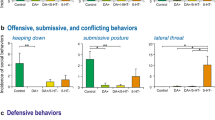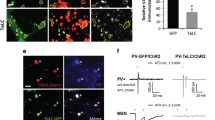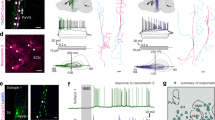Abstract
It is classically considered that Amphetamine acts by increasing extracellular dopamine levels. However, some data suggest a relevant role of other neurochemical systems. The striatum is of particular interest to the study of this question. We have investigated the involvement of the noradrenergic and serotonergic systems and their possible interaction in the striatal responses to Amphetamine using a double behavioral and immunohistochemical approach (i.e., changes in locomotor activity and striatal expression of Fos). In normal rats, Amphetamine induced locomotor hyperactivity and striatal expression of Fos. Pretreatment with the α1-adrenergic-receptor antagonist Prazosin or lesion of the serotonergic system significantly reduced the locomotor hyperactivity and striatal Fos expression induced by Amphetamine. Administration of Prazosin to rats with serotonergic denervation did not produce any further reduction in the Amphetamine-induced locomotor hyperactivity or striatal Fos expression compared with that observed in rats with serotonergic denervation only. Amphetamine did not induce a detectable increase in Fos expression in dopamine-denervated striata, and elicited intense rotation towards the dopamine-denervated side. This suggests that striatal dopamine release is essential in the Amphetamine-induced effects on striatal neurons. However, the noradrenergic system plays an important role, and the serotonergic system is necessary for mediating the effects of the Amphetamine-induced noradrenergic stimulation. Concurrent stimulation of dopaminergic and serotonergic receptors appears necessary to regulate Amphetamine-induced responses in the striatal neurons.




Similar content being viewed by others
References
Archer T, Fredricksson A, Jonsson G, Lewander T, Mohammed AK, Ross SB, Soderburg U (1986) Central noradrenaline depletion antagonizes aspects of D-amphetamine-induced hyperactivity in the rat. Psychopharmacology 88:141–146
Aston-Jones G, Shipley MT, Grzanna R (1995) The locus coeruleus, A5 and A7 noradrenergic cell groups. In: Paxinos G (ed) The rat nervous system. Academic Press, New York, pp 183–213
Baraban JM, Aghajanian GK (1980) Supression of firing activity of 5-HT neurons in the dorsal raphe by α–adrenoceptor antagonists. Neuropharmacology 19:355–363
Bhat RV, Baraban JM (1993) Activation of transcription factor genes in striatum by cocaine: role of both serotonin and dopamine systems. J Pharmacol Exp Ther 267:496–505
Blanc G, Trovero F, Vezina P, Hervé D, Godeheu AM, Glowinski J, Tassin JP (1994) Blockade of prefronto-cortical α1-adrenergic receptors prevents locomotor hyperactivity induced by subcortical D-amphetamine injection. Eur J Neurosci 6:293–298
Blandina P, Goldfarb J, Craddock-Royal B, Green JP (1989) Release of endogenous dopamine by stimulation of 5-hydroxytryptamine3 receptors in rat striatum. J Pharmacol Exp Ther 251:803–809
Cenci MA, Kalén P, Mandel RJ, Wictorin K, Björklund A (1992) Dopaminergic transplants normalize amphetamine- and apomorphine-induced Fos expression in the 6-hydroxydopamine-lesioned striatum. Neuroscience 46:943–957
Darracq L, Blanc G, Glowinski J, Tassin JP (1998) Importance of the noradrenaline-dopamine coupling in the locomotor activating effects of D-amphetamine. J Neurosci 18:2729–2739
De Deurwaerdere P, Bonhomme N, Lucas G, Le Moal M, Spampinato U (1996) Serotonin enhances dopamine outflow in vivo through dopamine uptake sites. J Neurochem 66:210–215
Dubocovich ML, Zahniser NR (1985) Binding characteristics of the dopamine uptake inhibitor 3H-nomifensine to striatal membranes. Biochem Pharmacol 34:1137–1144
Eilam D, Clements KVA, Szechtman H (1991) Differential effects of D1 and D2 dopamine agonists on sterotyped locomotion in rats. Behav Brain Res 45:117–124
Florin SM, Kuczenski R, Segal DS (1994) Regional extracellular norepinephrine responses to amphetamine and cocaine and effects of clonidine pretreatment. Brain Res 654:53–62
Graybiel AM, Moratalla R, Robertson H (1990) Amphetamine and cocaine induce drug-especific activation of the c-fos gene in striosome-matrix compartments and limbic subdivisions of the striatum. Proc Nat Acad Sci USA 87:6912–6916
Green AL, El Hait MA (1978) Inhibition of mouse brain monoamine oxidase by (+)-amphetamine in vivo. J Pharm Pharmacol 30:262–263
Grenhoff J, Svensson TH (1993) Prazosin modulates the firing pattern of dopamine neurons in rat ventral tegmental area. Eur J Pharmacol 233:79–84
Guerra MJ, Liste I, Labandeira-García JL (1998) Interaction between the serotonergic, dopaminergic, and glutamatergic systems in Fenfluramine-induced Fos expression in striatal neurons. Synapse 28:71–82
Hjorth S, Bengtsson HJ, Milano S, Lundberg JF, Sharp T (1995) Studies on the role of 5-HT1A autoreceptors and α1-adrenoceptors in the inhibition of 5-HT release-I. BMY7378 and prazosin. Neuropharmacology 34:615–620
Hudson JL, Van Horne CG, Stromberg I, Brock S, Clayton J, Masserano J, Hoffer BJ, Gerhardt GA (1993) Correlation of apomorphine and amphetamine–induced turning with nigrostriatal dopamine content in unilateral 6-hydroxydopamine lesioned rats. Brain Res 626:167–174
Kuczenski R, Segal DS (1989) Concomitant characterization of behavioral and striatal neurotransmitter response to amphetamine using in vivo microdialysis. J Neurosci 9:2051–2065
Kuczenski R, Segal DS (1990) In vivo measures of monoamines during amphetamine-induced behaviors in rats. Prog Neuro-Psychopharmacol Biol Psychol Suppl. 14:S37–S50
Labandeira-García JL, Rozas G, López-Martín E, Liste I, Guerra MJ (1996) Time course of striatal changes induced by 6-hydroxydopamine lesion of the nigrostriatal pathway, as studied by combined evaluation of rotational behaviour and striatal Fos expression. Exp Brain Res 108:69–84
Lategan AJ, Marien MR, Colpaert FC (1990) Effects of locus coeruleus lesions on the release of endogenous dopamine in the rat nucleus accumbens and caudate nucleus as determined by intracerebral microdialysis. Brain Res 523:134–138
Lindefors N, Ungerstedt U (1990) Bilateral regulation of glutamate tissue and extracellular levels in caudate-putamen by midbrain dopamine neurons. Neurosci Letters 115:248–252
Lipska BK, Jaskiw GE, Arya A, Weimberger DR (1992) Serotonin depletion causes long-term reduction of exploration in the rat. Pharmacol Biochem Behav 43:1247–1252
Liste I, Rozas G, Guerra MJ, Labandeira-García JL (1995) Cortical stimulation induces Fos expression in striatal neurons via NMDA glutamate and dopamine receptors. Brain Res 700:1–12
Liste I, Guerra, MJ, Caruncho HJ, Labandeira-García JL (1997) Treadmill running induces striatal Fos expression via NMDA glutamate and dopamine receptors. Exp Brain Res115:458–469
López-Martín E, Rozas G, Guerra MJ, Labandeira-García JL (1999) Recovery after nigral grafting in 6-hydroxydopamine lesioned rats is due to graft function and not significantly influenced by the remaining ipsilateral or contralateral host dopaminergic system. Brain Res 842:119–131
Mavridis M, Degryse AD, Lategan AJ, Marien MR, Colpaert FC (1991) Effects of locus coeruleus lesions on parkinsonian signs, striatal dopamine and substantia nigra cell loss after 1-methyl-4-phenyl-1,2,3,6-tetrahydropiridine in monkeys: a possible role for the locus coeruleus in the progression of Parkinson's disease. Neuroscience 41:507–523
Morgan JL, Curran T (1991) Stimulus-transcription coupling in the nervous system: involvement of the inducible proto-oncogenes fos and jun. Ann Rev Neurosci 14:421–451
Mounir A, Chkirate A, Vallée A, Pierret P, Geffard M, Doucet G (1994) Host serotonin axons innervate intrastriatal ventral mesencephalic grafts after implantation in newborn rats. Eur J Neurosci 6:1307–1315
Muñoz A, Rodriguez-Pallares J, Guerra MJ, Labandeira-Garcia JL (2003) Host regulation of dopaminergic grafts function: role of the serotonergic and noradrenergic systems in amphetamine-induced responses. Synapse 47:66–76
Neill DB, Grant LD, Grossman SP (1972) Selective potentiation of locomotor effects of amphetamine by midbrain raphe lesions. Physiol Behav 9:655–657
Paxinos G, Watson C (1986) The rat brain in stereotaxic coordinates. Academic Press, New York
Pierret P, Vallée A, Bosler O, Dorais M, Moukhles H, Abbaszadeh, Doucet G (1998) Serotonin axons of the neostriatum show a higher affinity for striatal than for ventral mesencephalic transplants: a quantitative study in adult and immature recipient rats. Exp Neurol 152:101–115
Pijnenburg AJJ, Honing WMM, Van der Hyden JAM, Van Rossum JM (1976) Effects of chemical stimulation of the mesolimbic dopamine system upon locomotor activity. Eur J Pharmacol 35:45–58
Ramirez OA, Wang RY (1986) Locus coeruleus norepinephrine-containing neurons: effects produced by acute and subchronic treatment with antipsychotic drugs and amphetamine. Brain Res 362:165–170
Rouquier L, Claustre Y, Benavides J (1994) α1-Adrenoceptor antagonists differentially control serotonin release in the hippocampus and striatum: a microdialysis study. Eur J Pharmacol 261:59–64
Sharp T, Zetterstrom T, Ljungberg T, Ungerstedt U (1987) A direct comparison of amphetamine induced-behaviours and regional brain dopamine release in the rat using intracerebral dialysis. Brain Res 401:322–330
Uretsky NJ, Snodgrass SR (1977) Studies on the mechanism of stimulation of dopamine synthesis by amphetamine in striatal slices. J Pharmacol Exp Ther 202:565–580
Wheeler D, Boutelle MG, Fillenz M (1995) The role of N-methyl-D-aspartate receptors in the regulation of physiologically released dopamine. Neuroscience 65:767–774
Williams JE, Woolverton WL (1990) The D2 agonist quinpirole potentiates the discriminative stimulus effects of the D1 agonist SKF-38393. Pharmacol Biochem Behav 37:289–292
Wüllner U, Testa CM, Catania MV, Young AB, Penney JB Jr (1994) Glutamate receptors in striatum and substantia nigra: effects of medial forebrain bundle lesions. Brain Res 645:98–102
Acknowledgements
This work was supported by grants from XUGA and the Spanish DGESIC (PGC).
Author information
Authors and Affiliations
Corresponding author
Rights and permissions
About this article
Cite this article
Muñoz, A., Lopez-Real, A., Labandeira-Garcia, J.L. et al. Interaction between the noradrenergic and serotonergic systems in locomotor hyperactivity and striatal expression of Fos induced by amphetamine in rats. Exp Brain Res 153, 92–99 (2003). https://doi.org/10.1007/s00221-003-1582-6
Received:
Accepted:
Published:
Issue Date:
DOI: https://doi.org/10.1007/s00221-003-1582-6




